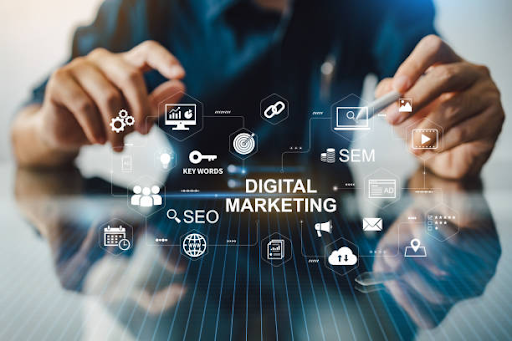In the ever-evolving realm of business, adapting to the digital age is not merely a choice but a necessity. As traditional marketing channels continue to recede in relevance, digital marketing emerges as the cornerstone of modern business strategies. In this blog, we will explore the dynamic landscape of digital marketing, dissecting its key components, strategies, and the impact it has on businesses worldwide.
Understanding Digital Marketing:
Digital marketing encompasses a broad spectrum of online activities aimed at promoting and selling products or services. Unlike traditional marketing, digital marketing leverages the power of the internet and electronic devices to connect with a target audience. From social media and content marketing to search engine optimization (SEO) and email campaigns, businesses today have an array of tools at their disposal to reach consumers in the digital space.
The Pillars of Digital Marketing:
Search Engine Optimization (SEO):
- SEO is the art and science of optimizing a website to rank higher on search engine results pages. This involves strategic use of keywords, creating high-quality content, and ensuring a website’s technical aspects are in top shape. A strong SEO strategy enhances visibility, driving organic traffic to a website.
Content Marketing:
- The phrase “content is king” remains as relevant as ever in the digital marketing landscape. Content marketing involves creating and distributing valuable, relevant content to attract and engage a target audience. Blog posts, videos, infographics, and podcasts are just a few examples of content marketing tools.
Social Media Marketing:
- Social media platforms have become integral to digital marketing strategies. Businesses leverage platforms like Facebook, Instagram, Twitter, and LinkedIn to connect with their audience, build brand awareness, and drive traffic to their websites. Social media marketing also involves paid advertising to reach a wider audience.
Email Marketing:
- Despite the rise of various communication channels, email marketing remains a powerful tool. It involves sending targeted messages to a group of people who have opted to receive updates from a business. Email marketing is effective for building relationships, promoting products, and nurturing leads.
Pay-Per-Click (PPC) Advertising:
- PPC advertising allows businesses to place ads on search engines and pay a fee each time their ad is clicked. This method of advertising can quickly drive targeted traffic to a website. Popular platforms for PPC advertising include Google Ads and Bing Ads.
Analytics and Data-driven Marketing:
- One of the strengths of digital marketing is the ability to gather and analyze vast amounts of data. Marketers use analytics tools to measure the performance of campaigns, understand user behavior, and make data-driven decisions to optimize strategies.
The Digital Marketing Funnel:
Digital marketing operates on the concept of a sales funnel, which represents the journey a potential customer takes from awareness to conversion. The funnel consists of three main stages:
Top of the Funnel (TOFU):
- At this stage, the focus is on creating awareness. Content like blog posts, social media updates, and videos are used to attract a broad audience.
Middle of the Funnel (MOFU):
- In the middle stage, the goal is to engage and educate the audience. This involves providing more in-depth content, such as ebooks, webinars, and case studies, to build trust and interest.
Bottom of the Funnel (BOFU):
- The final stage is conversion. This is where leads are encouraged to make a purchase or take a desired action through targeted content, special offers, and personalized communication.
Some current trends in digital marketing include:
Artificial Intelligence (AI) and Machine Learning:
- AI is being used to analyze consumer behavior, personalize content, and automate marketing processes, making campaigns more efficient and effective.
Video Marketing:
- With the rise of platforms like YouTube, TikTok, and Instagram Reels, video content has become a dominant force. Brands are increasingly using video to engage audiences and tell compelling stories.
Voice Search Optimization:
- As voice-activated devices become more prevalent, optimizing content for voice search is crucial. This involves using more conversational and natural language in content creation.
Interactive Content:
- Users now expect more than passive consumption. Interactive content, such as quizzes, polls, and interactive infographics, encourages active participation, enhancing user engagement.
Conclusion:
Digital marketing is not just a trend; it’s a fundamental shift in how businesses connect with their audience. As technology continues to advance, the landscape of digital marketing will evolve, presenting both challenges and opportunities. To thrive in this digital age, businesses must embrace the multifaceted nature of digital marketing, staying agile and innovative to meet the ever-changing demands of the online world. As the saying goes, “Go where your customers are,” and today, they are online, navigating the vast expanse of the digital landscape.







